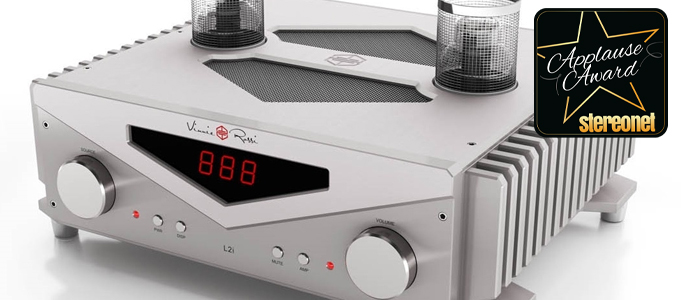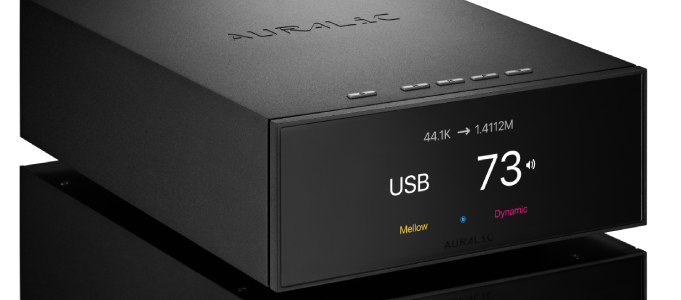Vinnie Rossi L2i Signature Edition Integrated Amplifier Review

Eric Teh reviews a striking high-end hybrid amplifier from a charismatic US hi-fi specialist…
Vinnie Rossie
L2i Signature Edition Integrated Amplifier
USD $18,995 MSRP

In many ways, the L2i Signature Edition amplifier is a product you would expect from Vinnie Rossi – it is distinctively different. He is well known for his quirky but loveable battery powered components, released under the Red Wine Audio brand. This is no exception and is radically designed and built to meticulous standards in Holden, Massachusetts, USA.
It combines a tube preamp circuit with a solid-state MOSFET power amp stage. The former is based on the 300B directly-heated triode (DHT), which is a rarity as 300Bs are typically used as power tubes. They only have three elements, namely a plate, grid and combined heater and cathode; by comparison, indirectly heated triodes have a separate heater to warm up the cathode. DHTs appeal to purists who believe they offer the most transparent and life-like sound possible.
Apart from the 300B tube, a switch on the rear panel allows you to change the filament voltage to 2.5V and 4V. This permits the use of other DHT tubes such as the 2A3, 45, PX4, 101D, 205D and SV811. Tube-rollers could go to town with choices and maybe save themselves some money. As an example, vintage 2A3 and 45 tubes are a more affordable alternative to the 300B. You could even pick up vintage Western Electric 101D tubes without the need to sell your internal organs.
Technically, no expense has been spared. The power supply and circuits are dual-mono. Belleson super regulators are used for voltage regulation while premium parts are used throughout such as the Yamamoto solid Teflon UX-4 tube sockets, discrete 64-step resistor ladder volume control and WBT NextGen binding posts. The unit is supported by a thick aluminium frame and Stillpoints Ultra mini footers.

The bypassable DHT preamp stage is mated to a Class AB MOSFET power amp stage using a single pair of output devices per channel claimed to deliver 100W RMS into an 8 ohm load or 170W RMS into 4 ohms. It is widely thought that a single pair of transistors for a push-pull design offers the purest sound, albeit at the expense of power output. You can also switch off the power amplifier section if you are using the L2i SE as a dedicated preamp.
The optional $3,495 DAC card is a dual-mono design too, with twin AKM AK4497EQ Velvet Sound DAC chip which handles everything up to PCM 768kHz and DSD512. USB, coaxial (BNC) and TOSLINK inputs are provided, and you can select between a non-oversampling filter or a minimum-phase digital filter mode. Turntable users are catered for too, with the optional $3,495 phono card offering three inputs (one MC, two MM) and a variety of gain (40dB to 72dB) and loading settings (10 to 1000 ohms). The circuit is direct coupled to minimise distortion. The L2i SE offers both single-ended and balanced inputs and outputs, with variable outputs that let it be used as a dedicated preamp if you so wish.
The L2i SE feels like the luxury piece of engineering that it is. The chassis measures 438x226x368 mm and weighs about 23kg. Knobs are tactile and smooth to use. The machining of the chassis is first rate with a solid response from the traditional knuckle test. The operation of the full metal-bodied remote is a delight too. One word of caution, though – 300B tubes can be microphonic, so care should be taken to place the L2i SE on a stable, non-resonant surface.
Throughout the audition period, the L2i SE was paired with my Vivid Giya G4 loudspeakers, and my analogue source was a Soulines Kubrick DCX turntable fitted with a Jelco TK-850S tonearm and Shelter 5000 MC cartridge. Digital sources were a Melco N1/ZH2 NAS, Totaldac d1-six DAC and a Weiss INT204 USB and S/PDIF bridge.

THE LISTENING
This amplifier produces a sonic landscape that is vivid, dramatic and largely realistic. It doesn't strive for studio neutrality but has instead a more dramatic style which yields a euphonic presentation. There's an inner glow in recordings that makes listening to music a beautiful and emotional experience.
Low frequencies are both powerful and controlled, with a nice textured quality that's like a typical tube-like bass on steroids. There is noticeable warmth and some upper mid-bass emphasis that gives this amplifier a full and ripe tone, yet it's coupled to tightness, depth and control that eludes most tube designs. The midband is similarly warm and laid back; vocals have a subtle, creamy and velvety quality, although the L2iSE doesn't overtly smooth over detail. Voices remain open and expressive, despite there being more body to them. Eva Cassidy's Tall Trees in Georgia from Live at Blues Alley can sound thin, sibilant and brittle in the wrong system. The L2i SE provides some sympathetic warmth that reduces the nasties while retaining the texture and nuances in Eva's voice.
High frequencies are deliciously airy, this amp recreating the recording's acoustic space and the decay from the instruments, but with a firmness and body that's quite unusual. Listening to the percussion work on Patricia Barber's Café Blue as an example, there was more emphasis on the strike on the cymbals compared to their fade. Firing up well-played audiophile tracks like Nils Lofgren's Keith Don't Go from Acoustic Live, the L2i SE reproduced this track with more sweetness and less of an edge than usual.

Spatially, this amplifier is lovely to listen to. From an imaging and soundstaging point of view, the L2i SE behaves very much like a fine tube design. Casting a wide and deep recorded acoustic, it proved able to place instruments and voices from several recordings that I auditioned, with precision. Each element of the mix had a realistic palpability with a clear portrayal of both the instrument/voice and the acoustic space surrounding it. 2V1G's To Whom I Give My Heart from Tempting Heart has a simple arrangement of just two female vocalists and an accompanying guitarist. Most good systems can place the performers in a clear horizontal plane, but the L2i SE was able to resolve the sound around the performers in both depth and height. You not only hear the pluck of the strings, but the resonance from the body of the guitar too.
Dynamically, while the Vinnie Rossi has sufficient power and grip to carry through the sense of scale for orchestral works, its relaxed timing would not make this amplifier my first choice for electronic dance music and other fast-paced programme material. Cueing up Daft Punk's Random Access Memories, the music lacked the snap and drive that is important in electronic dance music. However, when I switched to Bucky Pizzarelli's Swing Live, the Vinnie Rossi was in its element. While it is in no way rhythmically slow, the warm and saturated tonality favours more intimate and slower-paced music. It's the type of sound that places you in a smoky jazz bar in Tokyo, rather than a stadium rock concert.

The L2i SE's artistic lens makes music enjoyable, establishing a strong emotional connection between the recording and the listener. It employs some flattery to achieve its goals. So if you would like an analytic tool to dissect your recordings, you'll need to look elsewhere.
The optional phono stage and DAC cards are both high-quality and do not let the design down. Indeed they perform beyond their price level with few sonic compromises. Of the two, the star for me is the phono stage. Neutral, quick and resolving, it handled the delicate signals from my moving coil cartridge with a low noise floor and outstanding detail retrieval. I especially liked the ability to change cartridge loading settings on the fly using the remote control. If you already have a phono stage and DAC that you love to bits, then do feel free to omit the optional cards.
I also tried out the L2i SE as solely a preamplifier. Paired with monoblock amplifiers from Orchard Audio, the tone remained similar. My guess is that the DHT preamplifier stage is the tonal heart of this amplifier, while the rest of the circuits just pass the message on. Most of my time was spent with the stock EH Gold 300B tubes, but I also tried Takatsuki 300B and JJ 2A3-40 types. The latter tubes were incredibly refined, silky and organic. The JJs, on the other hand, were lighter, faster, and gave a more expressive tone. With the wide variety of tubes you can try, finding the perfect tubes to suit your taste will be easy.

THE VERDICT
 Vinnie Rossi's L2i Signature Edition integrated amplifier is a work of art that will proudly grace the finest of systems without having to make excuses. With the ever-shrinking real estate space available in cities, high quality integrated amplifiers make a lot of practical sense these days. Yes, the L2i SE is serious coin and out of reach to most audiophiles, but those lucky enough to be able to contemplate buying one should give it very serious consideration. The only caveat is its rather lavish and opulent voicing, one that might be a touch too sugary for some – so prospective purchasers would need to give this careful deliberation. Hear it if you can afford it!
Vinnie Rossi's L2i Signature Edition integrated amplifier is a work of art that will proudly grace the finest of systems without having to make excuses. With the ever-shrinking real estate space available in cities, high quality integrated amplifiers make a lot of practical sense these days. Yes, the L2i SE is serious coin and out of reach to most audiophiles, but those lucky enough to be able to contemplate buying one should give it very serious consideration. The only caveat is its rather lavish and opulent voicing, one that might be a touch too sugary for some – so prospective purchasers would need to give this careful deliberation. Hear it if you can afford it!
For more information visit Vinnie Rossi
Eric Teh
Tinkering since he was a wee little Audiophile, Eric also collects fountain pens and watches. He is on a never-ending journey to find the meaning to life, the universe and everything.
Posted in:Hi-Fi
Tags: vinnie rossi
JOIN IN THE DISCUSSION
Want to share your opinion or get advice from other enthusiasts? Then head into the Message Forums where thousands of other enthusiasts are communicating on a daily basis.
CLICK HERE FOR FREE MEMBERSHIP
Trending
applause awards
Each time StereoNET reviews a product, it is considered for an Applause Award. Winning one marks it out as a design of great quality and distinction – a special product in its class, on the grounds of either performance, value for money, or usually both.
Applause Awards are personally issued by StereoNET’s global Editor-in-Chief, David Price – who has over three decades of experience reviewing hi-fi products at the highest level – after consulting with our senior editorial team. They are not automatically given with all reviews, nor can manufacturers purchase them.
The StereoNET editorial team includes some of the world’s most experienced and respected hi-fi journalists with a vast wealth of knowledge. Some have edited popular English language hi-fi magazines, and others have been senior contributors to famous audio journals stretching back to the late 1970s. And we also employ professional IT and home theatre specialists who work at the cutting edge of today’s technology.
We believe that no other online hi-fi and home cinema resource offers such expert knowledge, so when StereoNET gives an Applause Award, it is a trustworthy hallmark of quality. Receiving such an award is the prerequisite to becoming eligible for our annual Product of the Year awards, awarded only to the finest designs in their respective categories. Buyers of hi-fi, home cinema, and headphones can be sure that a StereoNET Applause Award winner is worthy of your most serious attention.






